Research Article: Journal of Drug and Alcohol Research (2022) Volume 11, Issue 5
Study of Optimal Growth Parameter of Malassezia furfur MTCC 1374 and Screening for Lipid Media Enhancing Optimal Growth Phases
Rangasamy Dhanablan1*, Tehzeeb1, Irfan Ali Mohammed2, Abinaya Aruchamy1 and Kumaresan Manibharathi12Department of Pharmaceutical Sciences, Ibn Sina National College for Medical Sciences, Saudi Arabia
Rangasamy Dhanablan, Department of Microbiology, RVS College of Arts and Science, India, Email: dhanabalan@rvsgroup.com
Received: 02-May-2022, Manuscript No. jdar-22-63493; Editor assigned: 04-May-2022, Pre QC No. jdar-22-63493 (PQ); Reviewed: 18-May-2022, QC No. jdar-22-63493; Revised: 23-May-2022, Manuscript No. jdar-22-63493 (R); Published: 30-May-2022, DOI: 10.4303/jdar/236179
Abstract
The lipophilic unicellular yeast Malassezia furfur MTCC 1374 was studied for its growth parameters such as pH, Temperature, and Incubation time in days. The growth media was formulated with four lipid substrates to obtain four different lipid media such as M.furfur Corn oil media (MfCM), M.furfur Coconut oil media (MfCcM), M.furfur Ghee media (MfGM) and M.furfur Olive oil media (MfOM). The MfGM promoted moral growth of M.furfur when subject to different pH (4.0, 4.5, 5.0, 5.6 and 6), temperature ranging from 20°C to 45°C and incubation period from Day 0 to Day 20. In the entire M.furfur growth phase the stationary phase was observed from Day13 to Day16 in the MfGM under the favorable parameters of pH 5.6 and temperature 37°C. The stationary phase of the yeast M.furfur was observed for its enduring period. The range of optimum parameters promoting M.furfur upright growth was found to be the condition comparable to the human skin pH 5.5-5.6 as well as temperature 36°C-37°C. Other lipid Medias also favored fair growth with different stationary phase but not up to the level of MfGM.
Keywords
Malassezia furfur; Growth phase; Lipid media; Stationary phase
Introduction
The cutaneous commensal and unicellular Malassezia furfur is known for its clinical importance. The lipophilic fastidious yeast M.furfur grows and thrives only in the lipid environment and as a resident flora on the human skin rich in sebum. The actual role of this opportunistic yeast in the development of diseases and inducing infections in the skin is not clear. Although it is a commensal microorganism present on the stratum corneum of human skin, infection results when the dimorphic yeast changes to its mycelial form called YM shift. The YM shift during in vitro laboratory culturing is quite common in human fungi. A range of different components and conditions to induce mycelia in vitro by developing mycelial culture medium has already been reported. The single filamentous fungal genome combined with the historic number of sequenced genomes suggests that the secondary metabolite wealth of filamentous fungi is largely untapped. Identification of proper growth phase in M.furfur will pave a new arena for the production secondary metabolites in laboratory level. The present study explores the optimal growth parameters of a lipophilic yeast Malassezia furfur MTCC 1374 in terms of pH, Temperature and Incubation time in days as well as the lipid substrate enhancing the optimal growth [1-4].
Materials and Methods
Revival of standard yeast culture
Pure culture of M. furfur (MTCC: 1374) was procured from Institute of Microbial Technology, Chandigarh, India and revived with Emmon’s modified medium-M286 (HIMEDIA). In brief, 4.7 grams of media was suspended in 100 mL of distilled water, boiled to dissolve the medium completely, sterilized by autoclaving at 15 lbs pressure at 121°C for 15 minutes. Since the M.furfur is a lipophilic yeast thrives in acidic pH (<7.0) the final pH of the medium was adjusted to 5.6 (pH of Sabouraud Dextrose Agar (SDA)) at room temperature so as to enhance the growth of yeast. Prior to dispensing of the media in the petri plates, to inhibit the bacterial contamination in the growth media one vial of CC supplement-FD035 (CC-Cycloheximide: 200 mg Chloramphenicol: 25 mg) was rehydrated with 5 mL of distilled water, mixed well and aseptically added to 100 mL of sterile, molten, cooled (45°C-50°C) Emmon’s medium. Both broth and agar media were prepared for the revival and plating of yeast M. furfur respectively. The lyophilized culture (4 granules) of M. furfur was inoculated into 100 mL of broth medium, incubated at an orbital cum shaker maintained with 37°C at 150 rpm. The setup was observed day to day for the visible growth and the day of turbidity in the media was recorded as yeast appearance [5,6].
Phenotypic and physiological characterization
The morphological characteristics of M. furfur colonies were observed microscopically by adopting a method Tallform Coplin staining jars. Physiological characteristics such as Tween assimilation (Tween 20, 40, 60, and 80), utilization of Cremophor EL (Castor oil 2%, 4%, 6%, 8%) at 30°C, 32°C, 35°C, 37°C and 40°C, catalase production, and pigment production on tryptophan based medium were assessed based on the reference cited. In brief, the SDA medium (15 mL) at molten state was inoculated with 2 mL of M.furfur broth culture (1 × 107 cells/mL), mixed well and plated in petri dishes. Four wells were made by means of a 2 mm diameter punch one in each quadrant, loaded with 5 μL of 2% v/v Tween 20, 40, 60 and 80 monitored under incubation of plates for one week at room temperature. Utilization of Tween was considered based on the degree of yeasts growth around individual wells. Utilization of Cremophor EL was carried out same as that of Tween test where three wells are filled with 2%, 4% and 6% cremophor and the plates were incubated at RT for observation. The catalase production was confirmed by placing a drop of 3% hydrogen peroxide on a drop of broth culture placed on the glass slide. The production of gas bubbles was considered as catalase positive. For the identification of pigment production by M.furfur a tryptophan based medium with 3 mL of Tween 60, 0.05 g of Cychloheximide, 0.05 g of Chloramphenicol, 0.01 g of DL-Tryptophan and 1.5 g of agar in 100 mL of distilled water was prepared. The pH of the medium before sterilization was adjusted to 5.6±0.2 and a loopful of M.furfur broth culture was streaked on the pigment induction medium. The plates were incubated at room temperature for 3 weeks and observed for the production of pigment macroscopically and under UV light at 254 and 366 nm [7].
Selection of lipids enhancing M.furfur growth (Plate method)
The method is a preliminary qualitative screening amended for the selection of preeminent lipids promoting the M.furfur growth. About four different lipid substrates viz. Corn oil, Coconut oil, Ghee and Olive oil were incorporated in the preparation of four lipid media. In brief, individual petri plates with 15 mL sterilized SDA medium was overlaid by 0.1 mL of sterile lipids. A loop full of M.furfur broth culture was inoculated on the individual lipid media plates, incubated at room temperature and monitored for optimum growth in minimum days. Among the four types of lipid incorporated media, the medium with optimal perfect distinctive M.furfur growth was considered as M.furfur Lipid Media (MfLM), where the lipids may be corn oil/coconut oil/ghee/olive oil [8].
Determination of optimal growth parameter of M.furfur
Four different lipid broth media viz. M.furfur Corn oil media (MfCM), M.furfur Coconut oil media (MfCcM), M.furfur Ghee media (MfGM) and M.furfur Olive oil media (MfOM) were prepared using SDA as a base with an addition of 2 mL of above mentioned sterile lipids (Table 1). About 10 mL of each medium was dispensed in 50 mL conical flasks and the pH of the medium in the conical flask was adjusted to obtain a pH range from 4.0, 4.5, 5.0, 5.6, and 6.0 using 2M HCl (Hydrochloric acid) and 2M NaOH (Sodium Hydroxide). The pH of the media was adjusted and lipid substrates were added into the media before and after sterilization at 15 lbs pressure (121°C) for 15 minutes respectively. About 1 mL of revived broth culture (1 × 107 cells/mL) of M.furfur was transferred into the conical flasks with different pH and incubated at different temperatures. In brief, for each individual pH about eight broth duplicates were prepared so as to expose a lipid broth culture under different temperatures ranging from 20°C, 25°C, 30°C, 35°C, 37°C, 40°C, 42°C and 45°C. The flasks were examined for yeast growth from the D0 to D20. For every 24 hours about 2 mL of the sample was drawn from each conical flask at different pH exposed to varied temperatures and subjected to turbidity measurement under spectrophotometer at 600 nm with a path length of 1 cm. For each set of pH measurement the controls were maintained for the comparison and the absorbance readings were recorded to construct growth phase graph. The absorbance data’s were recorded for the comparison of optimal yeast growth and plotted in a graph, where the X axis holds time in days and Y axis supporting absorbance of M.furfur growth in the lipid media subjected to varied pH and temperatures. Throughout the study period controls (Sabouraud Dextrose broth without lipid source inoculated with 1 × 107 cells/mL of M.furfur) were maintained for comparison and readings were recorded [9].
Table 1: M.furfur lipid media (MfLM) composition.
| Ingredients | Gms/Litre |
|---|---|
| Dextrose (Glucose) | 40 |
| Neopeptone | 10 |
| Agar | 15 |
| Distilled Water | 1000 mL |
| Final pH (at room temperature) | 5.6 ± 0.2 modified accordingly |
| Selective lipid substrate overlaid after sterilization of the media for the enhancement of Malassezia furfur growth | |
| Lipid substrate- Ghee/Corn oil/ Coconut oil/Olive oil | 2 mL |
| MfCM | M.furfur Corn oil media |
| MfCcM | M.furfur Coconut oil media |
| MfGM | M.furfur Ghee media |
| MfOM | M.furfur Olive oil media |
| With exclusion of agar the broth media was prepared | |
Results and Discussion
In the present study the Emmons medium was used in the revival of M.furfur as per the procedure mentioned in the MTCC catalog. The yeast M. furfur is a member of monophyletic commensal habitually found on human and animal skin with lipid-dependent nature requires a strict supplement of lipid substrate for enhanced growth. In order to check the efficacy of the Emmons media in supporting M.furfur growth deprived of lipid our media preparation was made devoid of lipid substrate. In the Emmons media the growth of M.furfur was found to be deliberate with less turbidity only after 6th day under incubation. Similarly the colonies on the plate media also required longer incubation >7 days proving the slow growing nature of the yeast which may be due to the strict nutritional requirements such as lipid substrates and natural environment similar to the host skin. The sluggish nature of this fastidious yeast has already been described that laboratory culturing can be achieved only by specific growth substrates like lipids. References state the inability of M. furfur to synthesize fatty acids individually and hence colonize in the areas of the skin rich in sebaceous glands with sebum lipids. We also observed the addition of CC supplement is much mandate to inhibit the bacterial contamination throughout the period of incubation.
Besides, the present work also focused on the phenotypic and physiological characterization of the standard strain M.furfur MTCC 1374. The Eastman tall form coplin methylene blue staining of cells under microscope were found to be globose, oblong-ellipsoidal with a wide septum between mother and daughter cells. Unipolar broad based budding were also observed after 6th day of incubation specifically in broth culture, whereas in the plate culture the budding was identified only on 7th day onwards (Figure 1). The colonies on the Emmon’s medium plates appeared flat elevated, and entire with undulate margins. The colonies are shiny with white to tan cream colored and smooth pasty [10].
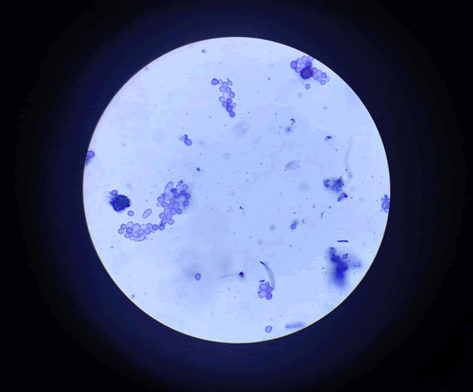
Figure 1: Microscopic observation of Malassezia furfur after staining in Methylene blue dye.
The yeast M.furfur was also confirmed for its Tween assimilation (2% of Tween 20, 40, 60, and 80), Cremophor EL (Castor oil 2%) at 30°C, 32°C, 35°C, 37°C and 40°C, catalase production, pigment production on tryptophan based medium (Table 2). According to the method reported by competence of Malassezia species to utilize different tween compounds as a unique lipid supplement was evaluated [9]. The Tween dependent growth assay was tested in SDA medium and the growth on Tween is indicative for external lipases that release the fatty acid tail from the nonionic detergents. The 2% nonionic detergent Tween 20, 40, 60 and 80 used in biochemical characterization of M.furfur confirmed the utilization and presence of polysorbate and lipase activity respectively. The utilization of tween and Cremophor (Plate 2) was observed on 7th day of incubation at RT in a growth medium with pH 5.6. Many studies reported about different lipid assimilation phenotypes in Malassezia genus and in the present study we assessed the standard strain M.furfur MTCC 1374 assimilating Tween 20, 40, 60, and 80 in different degrees by liberating the external lipases which could be an indication for the release of fatty acid tail from the tween compounds. Further utilization of Tween 80 was found to slower when compared to other Polysorbates. Several studies attribute the characteristics of lipase activity related to the adaptation of M.furfur in the fatty acid rich regions of the host body favoring the natural growing environment as well as the role of extracellular lipases in cellular growth processes and its relation in pathogenicity. However, there are atypical strains that have been identified to assimilate only Tween 80 compounds and some strains that are reported to be lipid- independent [11].
Table 2: Biochemical and physiological characterization of M. furfur (MTCC: 1374).
| Species | Utilization of Tween (2%) | Cremophor EL (2%) | Catalase reaction | Growth in SDA without lipid | Growth and pigment production in p-agar | Growth in Dixon agar | |||||||
|---|---|---|---|---|---|---|---|---|---|---|---|---|---|
| M. furfur (MTCC: 1374) | 20 | 40 | 60 | 80 | 25°C | 30°C | 37°C | 42°C | 37°C | 42°C | |||
| ++ | ++ | ++ | + | ++ | + | - | + | ++ | ++ | - | ++ | - | |
| ++: Good growth; +: Less growth; SDA: Sabouraud Dextrose Agar | |||||||||||||
Under hydrogen peroxide exposure the yeast M.furfur colonies were found to release catalase mediating the breakdown of hydrogen peroxide. The test for catalase enzyme is evident when a drop of hydrogen peroxide was introduced on the 7 days old colonies on the Emmons media petri plates, followed by the rapid elaboration of oxygen bubbles on the colonies to mitigate oxidative stress to a considerable extent by destroying cellular hydrogen peroxide. Pigment production by M.furfur in the tryptophan based medium was evident on longer incubation of three weeks with an inferior red to brown color in the media. Our trial by the addition of peptone in the medium did not encourage pigment production by the yeast. Interestingly the media with tryptophan without peptone encouraged pigment diffusion around M.furfur colonies displaying tryptophan was a substantial nitrogen source for pigment synthesis. Characterization of pigment production by M. furfur was dark brown but in the present work it was evident that the pigment was pale red to light brown in color with lower quantity under UV light at 366 nm [12].
Screening for lipids enhancing optimal growth of M.furfur
In the present study the M.furfur Ghee media (MfGM) has been focused in discussion to avoid too much of interpretation. In the qualitative plate technique adopted for screening optimal growth promoting lipid substrates enhancing M.furfur growth M.furfur Ghee media (MfGM) was found to enhance a visible growth on 4th day at room temperature. Other three lipid media viz. M.furfur Corn oil media (MfCM), M.furfur Coconut oil media (MfCcM), and M. furfur Olive oil media (MfOM) used in the screening were also found encouraging the growth rate of M.furfur but not up to the level of MfGM (Table 3). The method utilized Sabouraud dextrose media composition as a base incorporated with lipid substrates since the Emmons media promotes growth insufficiently in minimum period. Throughout our study we maintained the pH 5.6 of similar to SDA for all the four media [13].
Table 3: Lipid media’s enhancing M.furfur optimal growth.
| Lipids | Abbreviation | Growth rate |
|---|---|---|
| M.furfur Corn oil media | MfCM | ++ |
| M.furfur Coconut oil media | MfCcM | + |
| M.furfur Ghee media | MfGM | +++ |
| M.furfur Olive oil media | MfOM | ++ |
| +++: Excellent growth, ++: Good growth, +: Fair growth | ||
The preliminary screened MfGM was subjected to broth assay to standardize the growth parameters such as pH (4.0, 4.5, 5.0, 5.6, and 6.0 ± 0.2), Temperature (20°C, 25°C, 30°C, 35°C, 37°C, 40°C, 42°C and 45°C) and Incubation time in days (D0-D20 days). Comparatively the MfGM facilitated the M.furfur to proliferate favorably in ghee broth measured spectrophotometer at 600 nm (Plate 3). The growth phase of the yeast was exactly identified with minimum lag phase and the log phase in the media starts mostly on the 4th day in almost all incubation temperature and pH. Throughout the study each unique pH of MfGM was maintained constant exposing to diverse temperature. Lower the pH<5 promoted only inadequate growth and the pH between 5-5.6 showed fortified growth specifically the pH 5.6 was found to be the optimum. Besides the temperature <30°C did not encourage upright growth but the temperature between 30°C-37°C was found to be auspicious parameter for the growing M.furfur. Since the yeast M.furfur is a normal flora as well as opportunistic pathogen of human and other mammalian hosts, the body temperature of 37°C was reputable to be the most optimum growth augmenting temperature. Report from earlier studies publicized the optimum growth of M.furfur at pH 7 to 9, temperature 30± 2°C where the finding entirely contravenes with the present study. The present report was entirely a parameter study in lipids promoting optimal growth, temperature and pH of the yeast M.furfur was exactly identified. Recent study defines Malassezia species are fastidious and slow growing yeasts in which isolation from polymicrobial samples and selective culture media are needed [14].
Remarkably during the study period we identified the proliferating M.furfur cells in MfGM exhausted and entered into the stationary phase due to the unavailability of nutrients (lipids) characterized by cell cycle arrest, morphological, physiological, and biochemical changes. There was an extended logarithmic phase followed by a stationary phase under each pH subjected to variable temperature. The duration of stationary phase of M.furfur in MfLM was exactly identified (Figures 2-6) which could be more constructive for the isolation and identification of beneficial metabolites liberated in the medium. In vitro cultivation for growth curve based viable cell counts obtained with a fluorescent viability test describes the 48 hour (2 days) lag phase followed by 6 to 10 day logarithmic phase and decline phase from 11th day. The study also elucidated the decrease of cellular viability (5.2 × 107 viable cells/mL) on the 32nd day of incubation. The study does not disclose any retro pertaining to the stationary phase of the yeast. The author also enlightened the measurement of protein and carbohydrate contents in the media obtained from the different phases of M. furfur’s growth specifically on 2, 6, 10 and 28 days selected on the basis of the growth curve data. The researcher explicated the presence of highest protein and carbohydrate concentrations on the 10th day (end of the log phase). Furthermore at the end of 10th day in our study an adherent, or sessile, type of growth was not observed rather planktonic growth was detected. This might be the characteristic of yeast elementary initial utilization of lipid in the medium through its growth biochemical processes. The complete dissolution of lipid source (ghee) in the medium was observed at the end of the tenth day and this point could be the initial stage of stationary phase in M.furfur [15].
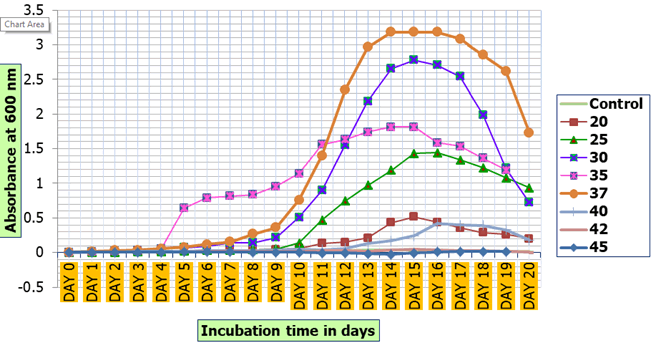
Figure 2: Growth curve of Malassezia furfur (MTCC 1374) at pH 4.0 under variable temperature in °C.
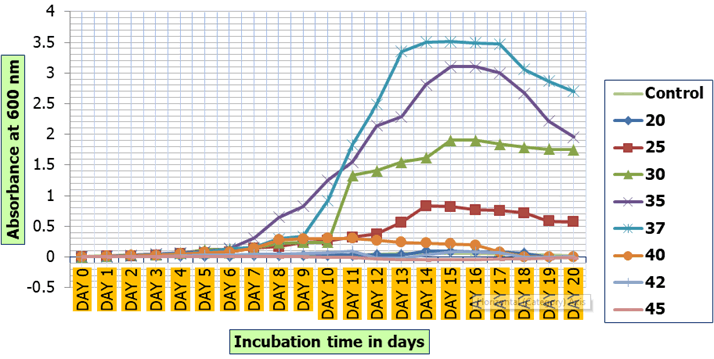
Figure 3: Growth curve of Malassezia furfur (MTCC 1374) at pH 4.5 under variable temperature in °C.
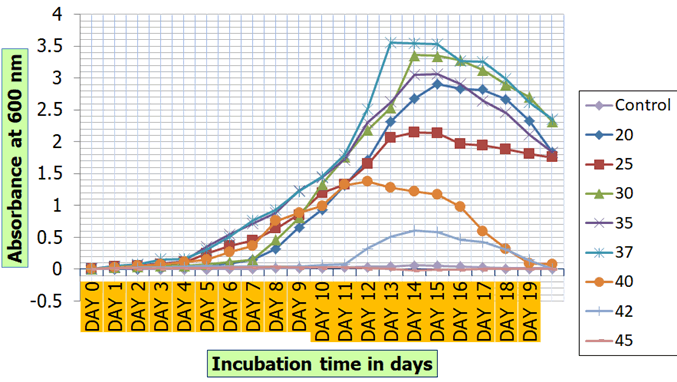
Figure 4: Growth curve of Malassezia furfur (MTCC 1374) at pH 5.0 under variable temperature in °C.
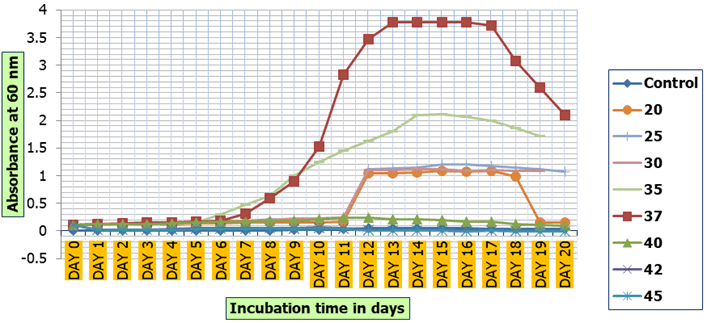
Figure 5: Growth curve of Malassezia furfur (MTCC 1374) at pH 5.6 under variable temperature in °C.
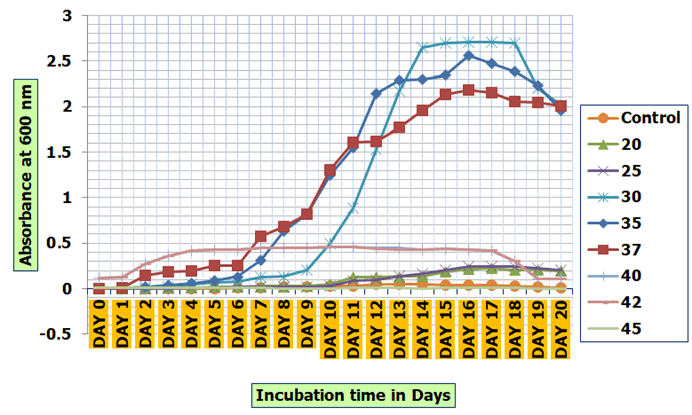
Figure 6: Growth curve of Malassezia furfur (MTCC 1374) at pH 6.0 under variable temperature in °C.
Further there was a significant variation in the stationary phase of M.furfur based on the parameter (pH, Temperature, and Incubation time in days) difference. At the pH of 4 the optimum stationary phase the yeast in MfGM was on Day14-16 at 37°C and there was a substantial decrease in extension of stationary phase with the increase in temperature >40°C. Again the MfGM at the pH of 4.5 maintained under 37°C was found to exhibit the stationary phase on Day14-15. We found that the most encouraging environmental parameters for M.furfur in the MfGM were pH 5-5.6, Temperature 30-37°C and the incubation time days were Day13-16. Providing all above conditional parameters in MfGM the present fastidious yeast can have its growth phase decided by cell cycle, morphological, physiological, and biochemical changes, whereas this will not ensue in condition of other media such as M.furfur Corn oil media (MfCM), M.furfur Coconut oil media (MfCcM), and M.furfur Olive oil media (MfOM). Subjected to the nature of lipid substrates provided for the proliferation the M.furfur can endure its growth phases which will be beneficial for the production useful metabolites for the present day research. The focused concept of this entire effort was to identify the stationary phase of the yeast in a specific lipid media so as to come out with beneficial secondary metabolites of Malassezia furfur MTCC 1374 [16,17].
Gandra et al., in his research on M.furfur in vitro cultivation for growth curve based viable cell counts obtained with a fluorescent viability test describes the 48 hour (2 days) lag phase followed by 6 to 10 day logarithmic phase and decline phase from 11th day. The study also elucidated the decrease of cellular viability (5.2 × 107 viable cells/mL) on the 32nd day of incubation. The study does not disclose any retro pertaining to the stationary phase of the yeast [18].
Conclusion
The author also enlightened the measurement of protein and carbohydrate contents in the media obtained from the different phases of M. furfur’s growth specifically on 2, 6, 10 and 28 days selected on the basis of the growth curve data. The researcher explicated the presence of highest protein and carbohydrate concentrations on the 10th day (end of the log phase). Furthermore at the end of 10th day in our study an adherent, or sessile, type of growth was not observed rather planktonic growth was detected. This might be the characteristic of yeast elementary initial utilization of lipid in the medium through its growth biochemical processes. The complete dissolution of lipid source (ghee) in the medium was observed at the end of the tenth day and this point could be the initial stage of stationary phase in M.furfur.
Funding
The infrastructure for this research was funded by Department of Biotechnology-Star College Scheme, New Delhi, Science and Technology Project Scheme under TNSCST, Chennai.
Acknowledgement
The authors, therefore, gratefully acknowledge DBT Star College Scheme and TNSCST.
Conflict Of Interest Statement
The authors declare no conflict of interest.
References
- Abdillah, S. Khelaifia, D. Raoult, F. Bittar, R. Ranque, Comparison of three skin sampling methods and two media for culturing Malassezia yeast, J Fungi (Basel), 6(2020), 350.
[Crossref] [Google Scholar] [PubMed] [Research Gate]
- H.E. Baillon, Traité de botanique médicale cryptogamique, Paris: Octave Doin, (1889), 234.
- T. Bart, C. Claudia, G. Georgios, B.I. Dimitrios, B. Teun, et al. Malassezia ecology, pathophysiology and treatment, Med Mycol, 56 (2018), S10–S25.
[Crossref] [Google Scholar] [PubMed] [Research Gate]
- S. Brunke, B. Hube, MfLIP1, A gene encoding an extracellular lipase of the lipid-dependent fungus Malassezia furfur, Microbiol, 152(2006), 547–554.
[Crossref] [Google Scholar] [PubMed] [Research Gate]
- Z. Gao, G.I. Perez-Perez, Y. Chen, M.J. Blaser, Quantitation of major human cutaneous bacterial and fungal populations, J Clin Microbiol, 48(2010), 3575-81.
[Crossref] [Google Scholar] [PubMed] [Research Gate]
- P.R. Glenister, Some useful staining techniques for the study of yeast, beer, and beer sediments, Amer Soc Brewing Chem Proc, 28(1970), 163–167.
- A. Gonzalez, R. Sierra, M.E. Cardenas, A. Grajales, S. Restrepo, et al. Physiological and molecular characterization of atypical isolates of Malassezia furfur. J Clin Microbiol. 47(2009), 48–53.
[Crossref] [Google Scholar] [PubMed] [Research Gate]
- E. Guého, G. Midgley, J. Guillot, The genus Malassezia with description of four new species, Antonie van Leeuwenhoek, (1996), 69337-355.
[Crossref] [Google Scholar] [PubMed] [Research Gate]
- J. Guillot, E. Guého, M. Lesourd, G. Midgley, G. Chevrier, et al. Identification of Malassezia species, J Mycol Med, (1996), 6103-110.
- A.K. Gupta, R. Batra, R. Bluhm, T. Boekhout, T.L. Dawson, Skin diseases associated with Malassezia species, J Am Acad Dermatol, (2004),785-98.
[Crossref] [Google Scholar] [PubMed] [Research Gate]
- N.P. Keller, Fungal secondary metabolism: Regulation, function and drug discovery, Nature Rev Microbiol, (2018).
[Crossref] [Google Scholar] [PubMed] [Research Gate]
- P. Mayser, A. Tows, H.J. Kramer, R. Weiss, Further characterization of pigment-producing Malassezia strains, Mycoses, (2004), 4734-39.
[Crossref] [Google Scholar] [PubMed] [Research Gate]
- M.R. Saadatzadeh, H.R. Ashbee, K.T. Holland, E. Ingham, Production of the mycelial phase of Malassezia in vitro. Med Mycol, 39(2001), 487-93.
[Crossref] [Google Scholar] [PubMed] [Research Gate]
- N. Shibata, N. Okanuma, K. Hirai, K. Arikawa, M. Kimura, et al. Isolation, characterization and molecular cloning of a lipolytic enzyme secreted from Malassezia pachydermatis, FEMS Microbiol Lett, (2006), 256137-144.
[Crossref] [Google Scholar] [PubMed] [Research Gate]
- R.R. Warner, J.R. Schwartz, Y. Boissy, T.L. Dawson, Dandruff has an altered stratum corneum ultrastructure that is improved with zinc pyrithione shampoo, J Am Acad Dermatol, 45(2001), 897-903.
[Crossref] [Google Scholar] [PubMed] [Research Gate]
- V. Zinkeviciene, D. Norkunas, D. Citavicius, Atypical non-lipid-dependent strains of Malassezia furfur, Cent Eur J Biol. 7(2012), 241-249.
[Crossref] [Google Scholar] [PubMed] [Research Gate]
- R.F. Gandra, T.A. Melo, F.E. Matsumoto, M.F.C. Pires, J. Croce, et al. Allergenic evaluation of Malassezia furfur crude extracts, Mycopathologia, 155(2002), 183–189.
[Crossref] [Google Scholar] [PubMed] [Research Gate]
- R. Vijayakumar, C. Muthukumar, T. Kumar, R. Saravanamuthu, Characterization of Malassezia furfur and its control by using plant extracts, Ind J Dermatol, 51(2006), 145-148.
Copyright: © 2022 Rangasamy Dhanablan, et al. This is an open access article distributed under the terms of the Creative Commons Attribution License, which permits unrestricted use, distribution, and reproduction in any medium, provided the original work is properly cited.

